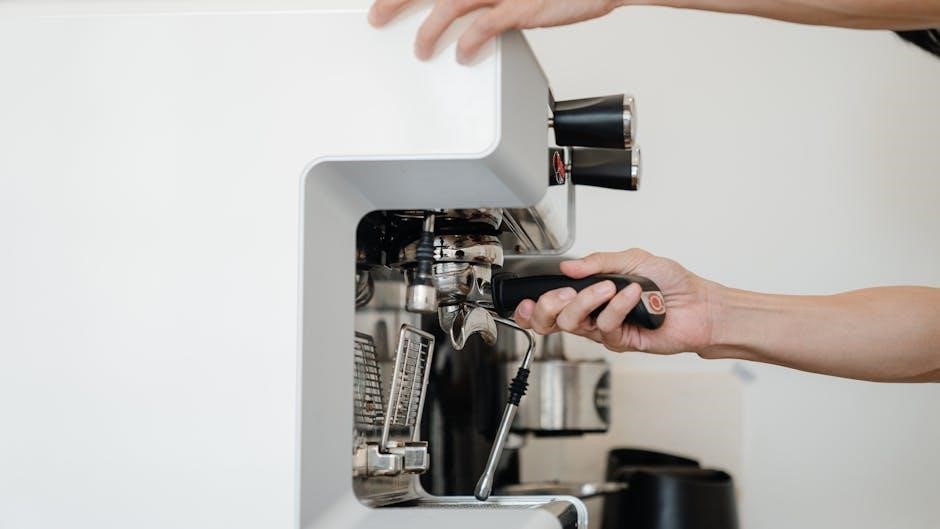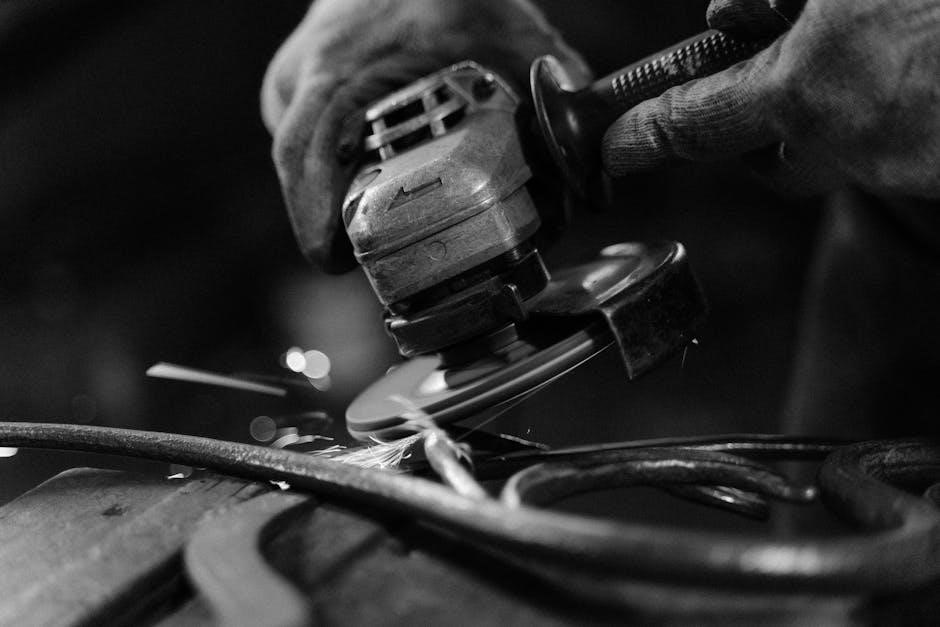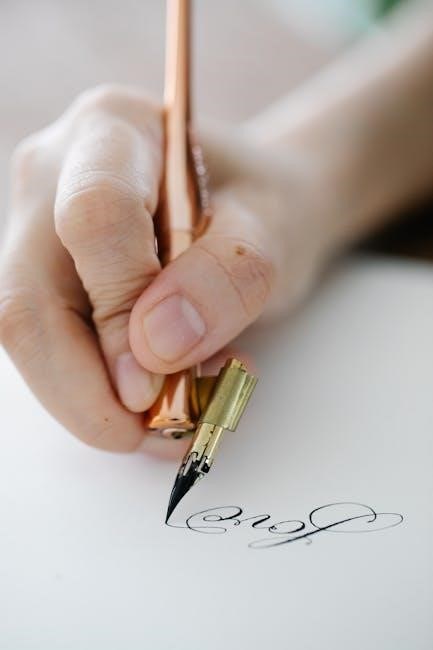Manual pool vacuuming is an essential maintenance task for keeping your pool clean and hygienic. It involves using a manual vacuum cleaner to remove debris and dirt from the pool floor and walls effectively. This method is particularly useful for small to medium-sized pools and provides a cost-effective, eco-friendly alternative to automatic cleaners. Regular manual vacuuming helps maintain clear water, prevents algae growth, and ensures a safe swimming environment for everyone.

Preparing to Use the Manual Pool Vacuum

Gather all essential equipment, including the vacuum head, telescoping pole, and hose. Ensure all components are securely connected to maintain proper suction and functionality. Before use, inspect the pool for large debris and skim the surface to optimize vacuuming efficiency. Adjust the water level if necessary to facilitate effective cleaning. Familiarize yourself with the vacuum’s operation to ensure safe and proper use.
2.1. Gathering Essential Equipment
To begin, you’ll need to gather all the necessary components for your manual pool vacuum. These typically include a vacuum head, a telescoping pole, a vacuum hose, and a brush for cleaning stubborn areas. The vacuum head is designed to glide across the pool floor, while the telescoping pole allows for easy reach without straining. The hose connects the vacuum head to the pump, ensuring proper suction. Additionally, a brush can be attached to the head for scrubbing tiles or walls, helping to remove algae and stains. Make sure all parts are in good condition and free from damage. If any components are missing or worn out, replace them before proceeding. Having everything ready will ensure a smooth and effective cleaning process. Proper equipment preparation is key to maintaining your pool’s cleanliness and safety.
2.2. Understanding the Components of the Manual Pool Vacuum
A manual pool vacuum consists of several key components that work together to clean your pool effectively. The vacuum head is the part that glides across the pool floor, collecting debris. It is usually made of durable plastic or rubber and is designed to fit snugly against the pool surface. The telescoping pole attaches to the vacuum head, allowing you to reach all areas of the pool without bending or straining. The vacuum hose connects the vacuum head to the pool’s pump, creating suction to remove dirt and debris. Some models also include a brush attachment for scrubbing tough stains or algae buildup on the pool walls or floor. Each component plays a vital role in the vacuuming process, and understanding how they function together is essential for proper use and maintenance. Regular inspection of these parts ensures optimal performance and longevity of the vacuum.

Preparing the Pool for Vacuuming
Before vacuuming, ensure the pool is free of large debris and the water level is optimal for suction. This step ensures efficient cleaning and prevents clogs in the vacuum system.
3.1. Removing Large Debris from the Pool Surface
Before vacuuming, it’s crucial to remove large debris like leaves, twigs, and insects from the pool surface. This prevents clogs in the vacuum hose and ensures efficient cleaning. Use a leaf skimmer or pool net to scoop up floating debris. For heavier objects, such as branches, manually remove them to avoid damaging the vacuum or pool liner. After skimming, inspect the pool floor and walls for any visible debris that may interfere with vacuuming. Additionally, empty the pump basket to ensure proper water flow and suction power. Regularly removing large debris also helps maintain clean water and prevents algae growth. Always prioritize this step to make the vacuuming process smoother and more effective. By clearing the surface first, you ensure a deeper and more thorough clean of your pool.
3.2. Testing and Adjusting the Pool Water Level
Before vacuuming, it’s essential to test and adjust the pool water level to ensure optimal performance of the manual pool vacuum. The water level should be at the recommended height, typically midway on the skimmer opening or as specified by the pool manufacturer. If the water level is too low, the pump may draw in air, reducing suction power. Conversely, if the water level is too high, it can cause overflow or inefficient skimming. To adjust the water level, add water if it’s too low or use a submersible pump to lower it if it’s too high. Always check the pool’s markings or guidelines for the ideal water level. Maintaining the correct water level ensures proper circulation, efficient cleaning, and prevents potential damage to the pool equipment. Regularly monitor and adjust the water level to keep your pool clean and functioning smoothly.

The Vacuuming Process
Manual pool vacuuming involves systematically cleaning the pool floor and walls using a vacuum head, hose, and pole. Regular passes ensure debris removal, promoting clear water and a well-maintained swimming environment.
4.1. Assembling the Manual Pool Vacuum
To assemble the manual pool vacuum, start by attaching the vacuum head to the telescoping pole. Ensure the connection is secure to maintain proper suction. Next, connect the vacuum hose to the head, making sure it is free from kinks or twists. Attach the other end of the hose to the pool pump or filtration system, following the manufacturer’s guidelines. If your vacuum includes a brush or additional cleaning attachments, securely fasten them to the vacuum head for improved debris removal. Before submerging the vacuum, check all connections for leaks or gaps to ensure optimal performance. Finally, test the vacuum by lowering it into the pool and verifying that it moves smoothly across the surface. Proper assembly is crucial for effective cleaning and to prevent damage to the equipment.
4.2. Vacuuming the Pool Floor
Begin by submerging the assembled manual pool vacuum into the water, ensuring the vacuum head is in full contact with the pool floor. Start in the shallow end and work your way toward the deep end, using slow, overlapping passes to cover the entire floor. This method helps prevent stirring up debris and ensures thorough cleaning. Keep the vacuum head close to the floor to maintain suction and avoid losing contact. For optimal results, vacuum in a pattern, such as moving in straight lines or a grid, to ensure no spots are missed. If you encounter stubborn dirt or algae, pause to let the vacuum suction work for a few seconds before moving on. Regularly empty the pump basket to maintain efficiency and avoid clogging. By following this process, you can effectively remove dirt, leaves, and other debris from the pool floor, leaving it clean and well-maintained.
4.3. Vacuuming the Pool Walls
After vacuuming the pool floor, shift your focus to the pool walls. To do this effectively, adjust the vacuum head to ensure it can glide smoothly along the vertical surfaces. Start at the top edge of the wall and work your way downward, using gentle, overlapping strokes to remove dirt and algae. Pay special attention to corners and crevices, where debris tends to accumulate. Use the brush attachment if available to loosen stubborn spots before vacuuming. Maintain steady, consistent pressure to avoid losing suction. If the vacuum head loses contact with the wall, reposition it carefully to reestablish a seal. For tile or fiberglass pools, be gentle to avoid scratching the surface. Regularly empty the pump basket to keep the vacuum running efficiently. By methodically cleaning the walls, you can achieve a spotless finish and maintain the overall hygiene of your pool.
4.4. Emptying the Pump Basket

Emptying the pump basket is a crucial step in maintaining the efficiency of your manual pool vacuum. Regularly cleaning the basket ensures that debris does not accumulate and impede the vacuum’s performance. Start by turning off the pump to halt water circulation. Locate the pump basket, typically found near the pump, and carefully remove it. Use gloves to protect your hands while handling the basket, as it may contain sharp or dirty debris. Empty the contents into a trash bag or designated area, taking care to dispose of all collected leaves, dirt, and other particles thoroughly. Rinse the basket with a garden hose if it’s particularly dirty. Once cleaned, reinstall the basket securely to ensure proper function. Regular emptying prevents clogs and maintains optimal suction power, keeping your pool clean and the vacuum functioning effectively. Always check and clean the basket after each use to uphold the system’s efficiency.

Maintaining the Manual Pool Vacuum
Regular maintenance ensures optimal performance and longevity of your manual pool vacuum. Clean the vacuum head, hose, and pump basket after each use to prevent debris buildup. Store the vacuum in a shaded, dry area to protect against sunlight and moisture. Lubricate moving parts as needed and replace worn brushes every few months. Inspect for worn or damaged components and address any issues promptly to maintain suction power and efficiency. Monitor performance and follow the manufacturer’s guidelines for specific maintenance recommendations. Establish a routine, such as weekly cleanups and monthly inspections, to keep your vacuum functioning effectively and extend its lifespan. Proper care will help prevent clogs, reduce wear, and ensure your pool remains clean and well-maintained.
5.1. Regular Cleaning and Inspection
Regular cleaning and inspection are crucial for maintaining the performance and longevity of your manual pool vacuum. After each use, rinse the vacuum head, hose, and other components with fresh water to remove dirt and pool chemicals. Pay special attention to the pump basket and skimmer, as debris can accumulate and clog the system. Use a soft brush or cloth to scrub away stubborn dirt or algae buildup. Inspect the vacuum head for worn brushes or cracks, and replace them if necessary. Check the hose for kinks, tears, or blockages, and ensure all connections are secure. Lubricate any moving parts periodically to keep them functioning smoothly. Regular inspection helps identify potential issues early, preventing major problems. Store the cleaned vacuum in a dry, shaded area to avoid sun damage. By maintaining a consistent cleaning and inspection routine, you can ensure your manual pool vacuum operates efficiently and effectively for years to come.

5.2. Storing the Vacuum Properly
Proper storage of your manual pool vacuum is essential to maintain its performance and extend its lifespan. After cleaning and inspection, ensure the vacuum is completely dry before storing to prevent mold or mildew growth. Drain any remaining water from the hose and vacuum head. Store the vacuum in a cool, dry place, away from direct sunlight, as UV rays can damage the materials. Avoid storing it near pool chemicals, as they can cause corrosion or degradation. If possible, elevate the vacuum slightly to prevent moisture from accumulating at the base. Consider using a storage bag or cover to protect it from dust and pests. Before storing, check for any blockages in the hose or connections and clear them to ensure proper function when you next use the vacuum. Proper storage will keep your manual pool vacuum in excellent condition, ready for its next use.

Troubleshooting Common Issues
Identify and resolve issues promptly to ensure optimal performance. Common problems include clogged hoses, air leaks, and worn brushes. Regular maintenance and inspections help prevent these issues and extend the vacuum’s lifespan.
6.1. Dealing with Clogs in the Vacuum Hose
Clogs in the vacuum hose are common and can disrupt the cleaning process. To address this, start by turning off the pump and carefully disconnecting the hose from the vacuum head. Inspect the hose for visible blockages, such as leaves or debris. If a clog is found, use a garden hose or a specialized tool to flush out the obstruction. For stubborn clogs, remove the hose from the pool and soak it in warm water mixed with mild detergent to loosen debris. After cleaning, reconnect the hose and test for proper suction. Regularly cleaning the hose and avoiding vacuuming large debris can prevent clogs. If the issue persists, consider replacing the hose to ensure efficient pool maintenance.
6.2. Addressing Air Leaks in the System
Air leaks in the manual pool vacuum system can significantly reduce suction power and efficiency. To identify leaks, inspect all connections, such as the hose, vacuum head, and pump. A hissing sound or visible bubbles in the water may indicate where the leak is located. Common culprit areas include worn-out O-rings, loose connections, or cracks in the hose. To fix leaks, tighten any loose fittings and replace damaged O-rings or gaskets. If the issue persists, apply a small amount of silicone-based lubricant to the seals to ensure a tighter fit. For more severe cracks, consider replacing the affected part entirely. Regularly inspecting and maintaining the system can prevent air leaks from occurring. After making repairs, test the system by submerging the vacuum head and checking for improved suction. A leak-free system ensures optimal performance and effective pool cleaning.
6.3. Replacing Worn-Out Brushes
Over time, the brushes on your manual pool vacuum may wear out, reducing their ability to effectively clean the pool surfaces. To replace them, start by turning off the pump and disconnecting the vacuum from the system. Inspect the brush assembly to identify any worn or damaged bristles. If the brushes are removable, use a screwdriver to detach them from the vacuum head; Purchase replacement brushes that match the manufacturer’s specifications to ensure compatibility. Once you have the new brushes, attach them securely to the vacuum head, making sure they are properly aligned and fastened. For non-removable brushes, you may need to replace the entire vacuum head. After installation, test the vacuum to ensure the new brushes are functioning correctly. Regularly inspecting and replacing worn brushes will maintain your vacuum’s efficiency and keep your pool clean. Always refer to the manufacturer’s guide for specific replacement instructions.

Safety Precautions
Always prioritize electrical safety when using a manual pool vacuum. Avoid using electrical equipment near water and ensure all connections are secure. Keep the area clear of obstacles to prevent tripping. Supervise children and pets during vacuuming to ensure their safety and avoid accidents.
7.1. General Safety Tips for Manual Pool Vacuuming
When using a manual pool vacuum, prioritize your safety and the safety of others. Always ensure the area around the pool is clear of obstacles to prevent tripping or slipping. Wear non-slip footwear and avoid vacuuming in wet or slippery conditions. Never use electrical appliances near water, as this can lead to shocks or accidents. Before starting, inspect the vacuum for any damage or wear, and ensure all connections are secure. Avoid vacuuming during strong winds or storms, as this can create unsafe conditions. Keep the vacuum away from children and pets, and never leave it unattended while in use. Additionally, always follow the manufacturer’s instructions for proper use and maintenance. If you feel tired or uncomfortable at any point, stop the process and rest. Lastly, ensure proper ventilation in the area to avoid inhaling dust or debris stirred up during vacuuming.
7.2. Safety for Children and Pets
Ensuring the safety of children and pets is crucial when using a manual pool vacuum. Always supervise children when they are near the pool, especially during vacuuming, as they may accidentally trip or fall into the water. Keep pets away from the pool area to prevent them from being startled or injured by the vacuum. Never allow children to play with the vacuum or its components, as this can lead to accidents or damage. Store the vacuum and its accessories in a secure, out-of-reach location when not in use to avoid any risks. Additionally, ensure that the pool gate or fence is closed and locked to prevent unsupervised access. By taking these precautions, you can create a safer environment for both children and pets while maintaining your pool.
Manual pool vacuuming is an essential part of maintaining a clean and safe swimming environment. By following the steps outlined in this guide, you can effectively vacuum your pool, remove debris, and ensure optimal water clarity. Regular maintenance and proper use of the manual pool vacuum will not only extend the life of your equipment but also keep your pool looking its best. Always remember to prioritize safety, especially for children and pets, and store the vacuum securely when not in use. With consistent effort and attention to detail, you can enjoy a pristine pool all season long. Happy cleaning!
